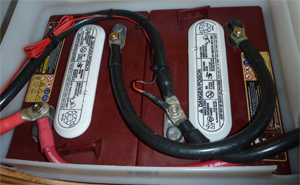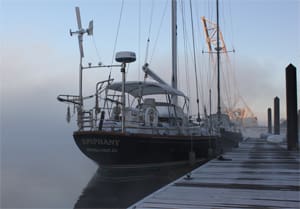Any boat owner who takes their vessel away from the dock knows that battery capacity becomes a concern. Figuring out how much capacity is needed would, at first, seem to be simple math. Add up all of the power consumers or loads, and the total is your answer. Of course, we all know nothing is ever that simple on a boat.
There are several reasons why calculating the needed battery capacity is not so cut and dried. The first problem is the batteries themselves. The common batteries used by most cruisers are the lead-acid type; this includes both wet cells and sealed or gel cells. New battery types, such as lithium-ion units, are becoming more common, but they are still expensive and usually require specialized monitoring and charging systems, so for now I am going to focus on the lead-acid batteries.
The first tricky part is to think about how power is used from a battery and how it might be restored or recharged. The very terminology used in rating this energy exchange becomes confusing as well. Most batteries are rated in amp-hours, or the amount of time a battery can supply a set amount of energy (amps) for a set amount of time (hours). Amp-hours, abbreviated Ah, is often confused as a unit of energy — it is not. It is a unit of energy and time, and it is important to keep this clear when thinking about energy usage on a boat. It cannot be stated that a device uses 10 Ah of energy; you can, however, state a device uses 10 amps for one hour.
Battery capacity is measured in amp-hours, as this is a way to set a standard for how a battery will perform. But, it has to be kept in mind that not all amp-hours are the same. Because batteries are used differently, the ratings have to reflect a particular type of use. Batteries designed to start an engine will need to release large amounts of energy quickly. To rate a battery’s ability to do this, a standard of cold cranking amps (CCA) is applied. Simply put, CCA is the amount of energy, measured in amps, that a battery will supply at 32° F for 30 seconds with the battery remaining above 1.2 volts per cell. Great for starting a cold car, but not so useful for how long a refrigerator will operate. This will be useful, however, for selecting a dedicated engine starting battery.
 |
|
A classic flooded cell lead-acid 12-volt battery. This one has a reserve capacity of 115 amps. |
A more important rating for a cruiser is reserve capacity (RC). This is the number of minutes a fully charged battery at 80° F will discharge 25 amps until the battery drops below 10.5 volts. This is the number that is really useful for most onboard applications, as it is used to help determine just how much battery capacity is available over a longer period of time. Keep in mind that these numbers are based on ideal conditions with fully charged, brand-new batteries. The results will not be as optimistic with a 2-year old battery that is only 80 percent charged, a situation more common on the average boat. It also needs to be kept in mind that most batteries should not be regularly discharged to this level. It is best if the voltage can be maintained above 11.5 volts or more.
It also must be understood that batteries are not like a gas can, where what you put in you get back out again. Batteries are more like a gas can filled with sponges of varying and changing characteristics. You are limited to how fast the gas will come out and how fast you can refill it. This must be kept in mind and taken into account when planning battery capacity. The faster the energy is removed, the less you will have over the long run. Likewise, batteries will only allow so much fuel to be poured back in at a certain rate; try to fill them too fast, and either they will not take the charge or something bad will happen.
The load side
With a better understanding of how battery ratings work, it is time to look at the loads. All of the DC equipment or consumers on a boat will measure their power use in amps and sometimes watts. The first thing to do is to make a list of loads along with their rated amp draw, then estimate the time that load will be used. It might be worthwhile to make a couple of lists, one for while at anchor and another for while at sea. Add the amps each item uses by the amount of time you think it will be used. Cabin lights may only be used for a few hours, while running lights will be on all night. An autopilot will run a lot while underway, while a radar may only be on at night or in fog. Try to be realistic and err on the side of more usage than less. These two lists will help with calculating just how much battery capacity is needed at different times and for different types of use.
Recharging
The next bit of information needed is how the batteries are going to be recharged. This is an important consideration that many neglect to take into consideration when planning the number of batteries needed. The temptation might be to just cram in as many large batteries as possible to get lots of capacity — the problem with all that capacity is that it needs to be recharged. Sometimes a smaller battery bank will work best for how the boat is used; the average modern car best illustrates this idea. Modern cars have lots of electronics, lights and systems to run, yet they still use a relatively small battery mainly sized for engine starting. They do not need big batteries because they have charging systems sized for the loads, and the battery is rarely used without the alternator running.
 |
|
Using the same make, model and age batteries in a house bank is a good idea. |
This is why knowing charging capacity and when that charging capacity will be available is important when selecting batteries. Most trawlers and powerboats will have good charging capacity while running from the engines. The only time they would need or use battery power alone is at anchor. For a sailboat under sail, additional charging power can come from solar and wind generators. All these charging sources need to be taken into consideration. As with the loads, it will help to make a list of charging sources and how long they will be online in a 24-hour period. Be conservative when doing the estimating. Do not use the full output for any source, as these are based on best-case scenarios, and instead use about 50 percent or so of the total output. Wind and solar can be tricky to estimate because they can vary considerably based on weather conditions and where the boat is operated.
With all this information, you can begin to think about how much battery capacity might be needed. For this figure, I suggest using around a quarter of what the reserve capacity is to be conservative. This will also account for the batteries not getting fully charged and reduced efficiency due to age. Overestimate your usage and you will come up with a figure that should be a good guideline for how much battery capacity will be needed. I always suggest starting with a smaller battery bank and building on that, should it not meet your needs. Keep in mind: A larger battery bank will also have to be matched with larger charging capacity if the batteries are not always going to be undercharged.
Selecting the right battery capacity is really a balance of use and charging. Most systems on cruising boats are not simply just drawing down the batteries and then recharging them, but rather a combination of simultaneous use and charging. This can change the dynamics of how a system works and can greatly change how much battery capacity is needed. Finding this balance is never easy, and there are no set formulas that will give an exact answer. In the end, a bit of trial and error might be what is needed to come up with the ideal setup.
Wayne Canning is a marine surveyor and consultant, as well as a writer and photographer. His website is 4ABetterBoat.com.

